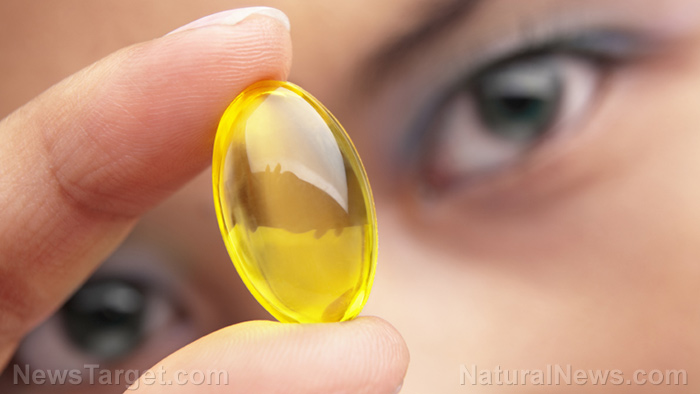9 Natural ways to prevent osteoporosis
03/04/2020 / By Zoey Sky

Those at risk for osteoporosis and looking to prevent the condition can do so by following a healthy diet, supplementing with calcium and vitamin D, and exercising regularly.
While none of the remedies below is a silver bullet for osteoporosis, they’re not linked to any adverse effects, unlike commercial medications.
Dietary intervention and nutritional supplements
Your body needs calcium so your heart, muscles and nerves can function properly.
Calcium deficiency is linked to osteoporosis, and studies show that low calcium intake throughout your life is associated with low bone mass and high fracture rates.
Healthy food sources of calcium include:
- Broccoli
- Milk
- Orange juice, fortified with calcium
- Sardines (canned in oil, with edible bones)
- Turnip greens, boiled
- Yogurt, plain
You also need vitamin D so your body can absorb calcium.
Dietary sources of vitamin D include:
- Egg yolks
- Fortified milk
- Liver
- Saltwater fish
Taking calcium and vitamin D supplements for the prevention and treatment of osteoporosis isn’t considered “alternative” since numerous studies show that they are effective.
Moreover, mounting evidence suggests that a holistic program of nutritional supplementation with bone growth factors, boron, magnesium, silica and vitamin K can benefit those who wish to prevent osteoporosis.
Following the reference daily intake (RDI) of these bone-related nutrients is affordable and dietary supplements are a good idea if you want to improve your bone health.
Your pineal gland produces the hormone melatonin, which is a natural sleep aid and an anti-inflammatory agent. Studies suggest that melatonin can promote healthy bone cell growth.
You can purchase melatonin as capsules, tablets and liquid form. While the hormone is touted as safe to take, it may cause drowsiness. Before taking melatonin, consult your naturopathic physician if you’re taking antidepressants, beta-blockers or blood pressure medications to avoid potentially adverse effects.
Kacip fatimah
Kacip fatimah (Labisia pumila) is a Malaysian herb that is the focus of various studies.
To date, completed scientific studies are still at the laboratory safety testing stages. However, extracts of the herb were shown to enhance the collagen connections in bone after menopause.
Tualang honey
Researchers in Malaysia have conducted clinical studies of the benefits of a locally produced “tualang” honey for bone health in postmenopausal women.
Results revealed that tualang honey is full of potent antioxidants. Tualang honey also contains more antioxidant phenols compared to other kinds of tropical honey tested in the study.
Tropical honey is full of antioxidants that prevent spoilage. Laboratory tests showed that the quercetin content of tualang honey may be responsible for the decreased activity of bone-destructive osteoclasts.
In a clinical trial with Malaysian women, researchers observed that taking 20 g of tualang honey per day helped restore bone mineral density.
Exercise
Around 43 clinical studies that observed more than 4,000 women have examined the benefits of exercise in preventing and treating osteoporosis.
Data showed that no-weight bearing but vigorous exercise was best for preventing femoral fractures (fractures of the femur).
Progressive weight training was found to be the most effective form of exercise for preventing fractures of the spine. In general, exercise can slightly increase bone mineral density and reduce the risk of fractures.
To improve bone mineral density, have at least three 12- to 20-minute sessions of exercise every week. Physical activity won’t strengthen your bones, but it will help strengthen your muscles and reduce the number of falls.
Yoga
In a study conducted by researchers from Rockefeller University and New York University, findings showed that a daily 12-minute yoga routine may reverse bone loss caused by osteoporosis.
A group of 741 volunteers did the routine for 10 years and researchers noted that the average increase in bone mineral density in the hip was 50 percent.
Magnet therapy
Magnet therapy cures for osteoporosis don’t use regular magnets.
Magnets that make a difference create a pulsating current. A pulsating magnetic field helps all kinds of cells expel sodium, import potassium, and modify their surface voltage to improve mineral absorption.
Both bone cells and pancreatic cells are particularly susceptible to this form of treatment.
Natural dentistry
Natural health practitioners caution against using mercury amalgams for filling cavities since the material is toxic.
It is believed that titanium in dental implants causes granulomas that weaken the bone, but further study is needed to verify this claim.
Animal therapy
An unusual study suggests that a cat’s purring can help naturally maintain bone mineral density. If not for the purring, the bone mineral density of cats would be depleted due to long periods of sleep and inactivity.
If you have osteoporosis and are caring for a feline friend, snuggling with them may benefit your bone health. Cats purr in the range of 20 to 140 Hz, which can help lower your stress hormone levels that can interfere with bone formation.
To boost your bone health, follow a balanced diet, take calcium and vitamin C supplements and exercise regularly.
Sources include:
Submit a correction >>
Tagged Under:
#nutrition, aging secrets, bone fractures, bone health, calcium, diet, disease prevention, exercise, food cures, functional food, natural health, nutrients, osteoporosis, prevention, supplements, vitamin D
This article may contain statements that reflect the opinion of the author
RECENT NEWS & ARTICLES
FoodCures.News is a fact-based public education website published by Food Cures News Features, LLC.
All content copyright © 2018 by Food Cures News Features, LLC.
Contact Us with Tips or Corrections
All trademarks, registered trademarks and servicemarks mentioned on this site are the property of their respective owners.





















